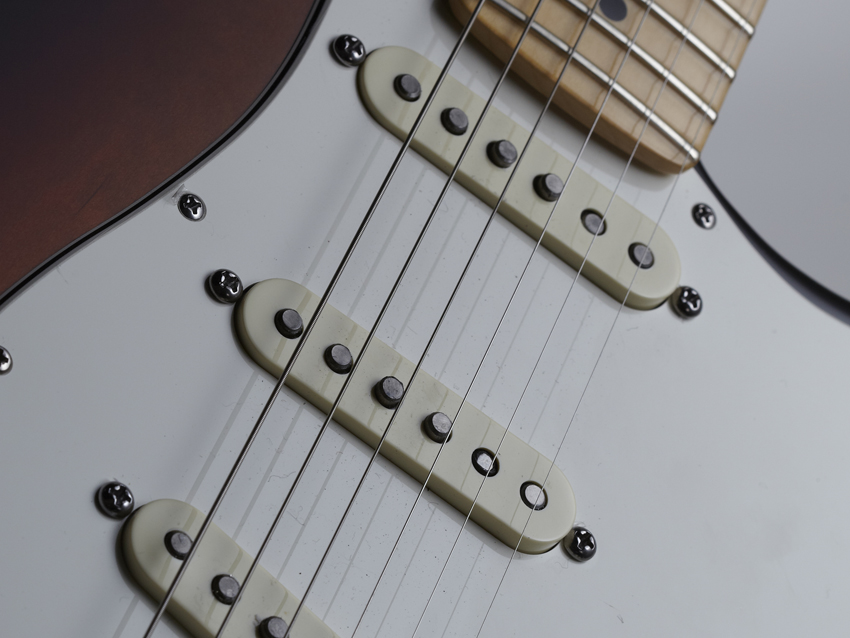MusicRadar Verdict
Not the most vintage or modern Strat in Fender's range, but hard to fault on any level.
Pros
- +
Build quality; player-centric upgrades; mainstream feel; playability and sounds.
Cons
- -
Over-egged fingerboard finish.
MusicRadar's got your back

Fender American Standard Stratocaster 2012

Fender American Standard Stratocaster 2012
The progressive journey of the electric guitar has been one of subtle tweaking and 'improving', albeit not always for the best. This new Strat typifies that evolution. So what's on offer here?
Pickups here are Custom Shop Fat '50s with a vintage-style stagger to the magnetic slug pole pieces.
"Clean tones have it all - from the timeless funk in the mixed positions to the clean, bell-like projection from the darker neck pickup and the bright-enough-for-most middle pickup."
Wiring is modern Fender: a standard five-way, master volume, neck tone and a notched no-load tone control for the bridge and middle pickups that, when fully on, effectively bypasses the pot, adding a soupçon of high-end.
Other than that, things are very similar to the previous models. It shares the same mainstream 'C' profile as the new Tele Standard - it's very slightly thinner-depthed, but it's minimal.
The two-post vibrato block has deeper drilled string holes so there's less dead string in the block, like a vintage-style vibrato, and the block is tapered at the rear to allow a little more down-bend. The arm still screws in - there's no tension adjustment but, as supplied, it has generous travel.
Tuners are the familiar non-locking modern types. The low E and A string tuners have a higher post-hole position; the other four tuner post-holes are closer to the face of the headstock.
Want all the hottest music and gear news, reviews, deals, features and more, direct to your inbox? Sign up here.
With only one string tree this helps to provide enough down-pressure over the nicely cut synthetic bone nut.
The Strat's neck is all maple - there's no separate fingerboard. The frets slot into the face of the neck, which is then finished.
There is some pooling of the finish either side of the frets, and it does look a little thicker than on a vintage specification maple 'board. It also slightly widens the fret size and, perhaps more importantly, reduces the height of the fret above the playing surface.
Sounds
The Stratocaster's set-up is low and slinky, fast with plenty of new-guitar zing. In fact that middle/bridge no-load tone control adds a little too much high-end for most styles, and it sounds more natural backed off a little.
Clean tones have it all - from the timeless funk in the mixed positions to the clean, bell-like projection from the darker neck pickup and the bright-enough-for-most middle pickup. The bridge pickup can be an ear-slicer - hardly surprising - yet in comparison with some other Strats, there's a musical width to the sounds here, almost three-dimensional compared to our Mexican Road Worn, which sounds a little hotter, but more focused.
But there's certainly plenty of clarity and high-end sparkle, so that light-to-medium-gained tones need a little taming for more mid-range push. With some tone reduction we're getting more into earthier 'hot blues' sounds, darker and snappier, and if you decide to use the mixed pickup tones here, at least they're hum-cancelling.
It's very hard to fault this guitar technically, though we'd prefer a slightly thinner finish on our Strat's maple 'board.
There are certainly more vintage-styled new versions of this Fender classic, or indeed more modernist tweaked versions. Yet reflecting on our sound tests, we'd be more than happy to walk on any stage with this one.
Dave Burrluck is one of the world’s most experienced guitar journalists, who started writing back in the '80s for International Musician and Recording World, co-founded The Guitar Magazine and has been the Gear Reviews Editor of Guitarist magazine for the past two decades. Along the way, Dave has been the sole author of The PRS Guitar Book and The Player's Guide to Guitar Maintenance as well as contributing to numerous other books on the electric guitar. Dave is an active gigging and recording musician and still finds time to make, repair and mod guitars, not least for Guitarist’s The Mod Squad.
